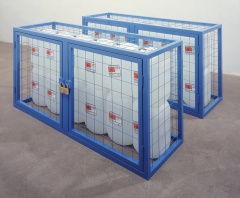Formaldehyde
| Infobox on Formaldehyde | |
|---|---|
| Example of Formaldehyde |  |
| Facts | |
| Origin | - |
| Stowage factor (in m3/t) | - |
| Humidity / moisture | - |
| Ventilation | - |
| Risk factors | See text |
Formaldehyde
Description
Formaldehyde is an organic compound with the formula CH2O or HCHO. It is the simplest aldehyde, hence its systematic name methanal. The common name of the substance comes from its similarity and relation to formic acid.
A gas at room temperature, formaldehyde is colourless and has a characteristic pungent, irritating odour. It is an important precursor to many other materials and chemical compounds. In 2005, annual world production of formaldehyde was estimated to be 8.7 million tonnes. Commercial solutions of formaldehyde in water, commonly called formol, were formerly used as disinfectants and for preservation of biological specimens.
In view of its widespread use, toxicity and volatility, exposure to formaldehyde is a significant consideration for human health. In 2011, the US National Toxicology Program described formaldehyde as "known to be a human carcinogen"
Derivation: Oxidation of synthetic methanol or low-boiling petroleum gases such as propane and butane. Silver, copper, or an iron-molybdenum oxide are the most common catalysts.
Formaldehyde is an important chemical used widely by industry to manufacture building materials and numerous household products. It is also a by-product of combustion and certain other natural processes. Thus, it may be present in substantial concentrations both indoors and outdoors.
Sources of formaldehyde in the home include building materials, smoking, household products, and the use of un-vented, fuel-burning appliances, like gas stoves or kerosene space heaters. Formaldehyde, by itself or in combination with other chemicals, serves a number of purposes in manufactured products. For example, it is used to add permanent-press qualities to clothing and draperies, as a component of glues and adhesives, and as a preservative in some paints and coating products.
In homes, the most significant sources of formaldehyde are likely to be pressed wood products made using adhesives that contain urea-formaldehyde (UF) resins. Pressed wood products made for indoor use include: particleboard (used as sub-flooring and shelving and in cabinetry and furniture); hardwood plywood panelling (used for decorative wall covering and used in cabinets and furniture); and medium density fiberboard (used for drawer fronts, cabinets, and furniture tops). Medium density fiberboard contains a higher resin-to-wood ratio than any other UF pressed wood product and is generally recognized as being the highest formaldehyde-emitting pressed wood product.
Other pressed wood products, such as softwood plywood and flake or oriented strand board, are produced for exterior construction use and contain the dark, or red/black-coloured phenol-formaldehyde (PF) resin. Although formaldehyde is present in both types of resins, pressed woods that contain PF resin generally emit formaldehyde at considerably lower rates than those containing UF resin.
Application
Urea and melamine resins, polyacetal resins, phenolic resins, ethylene glycol, pentaerythritol, hexamethylenetetramine, fertilizer, disinfectant, biocide, embalming fluids, preservatives, reducing agent as in recovery of gold and silver, corrosion corrosive inhibitor in oil wells, durable-press treatment of textile fabrics, industrial sterilant, treatment of grain smut, foam insulation, particle board, plywood, a versatile chemical intermediate.
Shipment / Storage
Shipped in drums, barrels, bottles or carboys. Usually sold and transported as a 40% aqueous solution, and under certain circumstances may become a white solid.
If carried in kegs or barrels there is usually a loss in weight and corrosion of the fastenings if these are of metal. May develop acidity; this causes considerable depreciation and is usually due to the presence of inherent impurities. If packed in a freight container, on unpacking, time should be allowed for dispersal of any fumes, before entering container.
Risk factors
Moderate fire risk. Toxic by inhalation. Strong irritant carcinogenic (solution).
Formaldehyde, a colourless, pungent-smelling gas, can cause watery eyes, burning sensations in the eyes and throat, nausea, and difficulty in breathing in some humans exposed at elevated levels (above 0.1 parts per million). High concentrations may trigger attacks in people with asthma. There is evidence that some people can develop a sensitivity to formaldehyde. It has also been shown to cause cancer in animals and may cause cancer in humans. Health effects include eye, nose, and throat irritation; wheezing and coughing; fatigue; skin rash; severe allergic reactions. May cause cancer. May also cause other effects listed under "organic gases."
For overseas carriage aspects of Chemicals, the readers are recommended to acquire or have access to a good chemical dictionary, and a copy of the International Maritime Dangerous Goods (IMDG) Code, issued by the International Maritime Organisation. Also consult the applicable MSDS sheet.











